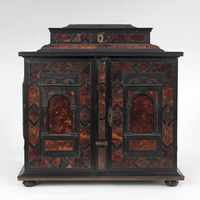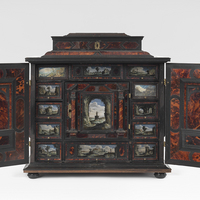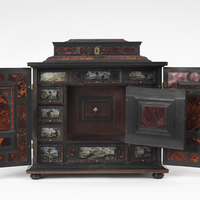Origins
Appropriately named an “art cabinet,” this Kunstkast was likely assembled in the city of Antwerp sometime in the second half of the seventeenth century. Its provenance before it was gifted to the Mead by the son of collector Charles Kingsley Arter in 1961 is unknown. A first for the Mead’s collection, this cabinet is an example of the high level of luxury achieved when the worlds of art and commerce intertwine.
The history of the cabinet could begin with its beautiful ebony veneer. This luxury wood was likely imported through Amsterdam following the establishment of the Dutch East India Company in 1602. From there the wood would have made its way to the popular cabinet-making city of Antwerp, which, after the Thirty Years’ War (1618–1648), surpassed Augsburg as a major production center, owing to the decrease in the number of workshops in Augsburg as a result of the war.
In Antwerp, the sharp rise in popularity of wood furniture, particularly ebony, created a divide between those artisans who worked as cabinetmakers and those who worked mainly with picture frames. An official division was made in 1620, which led to the creation of a guild exclusively for cabinetmakers, while the frame makers stayed with the established Guild of Saint Luke. In Augsburg, consumer weariness of imitation ebony—often pearwood that had been stained black—caused members of the guild to require the word eben be stamped on their products. In contrast, the city of Antwerp decided that the fake pieces should be marked with an “S” for Spaensch hout (Spanish wood), although this mark has yet to be found on any known piece.
When its doors are open, the cabinet reveals a series of thirteen églomisé paintings, likely the work of a Flemish artist. Églomisé refers to oil painting on glass, applied in reverse so that the foreground details are done first. Painted scenes ranged from landscapes to biblical scenes to myths. It is in the assembly of these materials that the skill of the dealer comes to light. Due to the wide popularity of these cabinets, the job of the dealer required them to keep record of the painters hired to paint the panels, the furniture workshop where the cabinet was being assembled, and the clients, who were all over Europe. Furniture makers typically worked for three to four weeks on assemblage, while the painters were given two weeks. The production method led to a finished piece where overall appearance, as Rainer Baarsen states in his analysis of dutch cabinets within the Rijksmuseum, “was more important than careful finishing or subtle design”.


